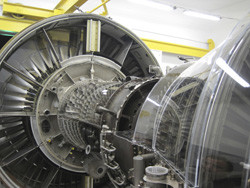Sensor network that can take the heat
The electronics in the engine control unit, the brains of the full authority digital engine control (FADEC), are not rated for operation at very high temperatures and are located on the engine fan casing.. There is interest in placing electronics with sensors near to the engine core without special cooling systems.The use of high-temperature electronics would eliminate special fuel pumping, fuel interfacing and complex heat sinks required to do that. Scientists explored the use of Silicon on Insulator (SOI) technology to overcome performance issues with silicon-based electronics at high temperatures. EU-funding of the project 'Development of high temperature survival electronic devices for engine control systems' (HIGHTECS) provided financial support. The team developed a high-temperature electronics platform with engine sensor elements and signal conditioning capability. Analogue signals from on-engine sensors for temperature, strain and vibration were fed to an analogue-to-digital converter (ADC). A high-integrity digital output would be input to the FADEC and/or an engine health monitoring system for enhanced efficiency with reduced cabling and complexity. Targets were operating temperatures of 200 degrees Celsius and short-term up to 250 degrees Celsius, and 50 000 engine flight hours. Matching temperature and voltage requirements for all the electronic components was quite complex. The ADC supplied to the project was sensitive to supply voltage and did not meet its own specifications. The voltages required to alleviate the discontinuities were above those recommended for the SOI application-specific integrated circuit (ASIC). Redesign of the ASIC improved performance of the analogue sensor conditioning and frequency measurement components, but the ADC output was still not linear at the 5 V power supply voltage recommended for the SOI technology. Further research will address development of an ADC functioning well at the voltage required by the SOI ASIC. Long-term storage tests at 250 degrees Celsius confirmed that the longevity of the SOI device exceeded the targeted 50 000 hours for the flight temperature profiles provided. HIGHTECS made important progress in development of a SOI high-temperature engine sensor platform complete with signal conditioning. Successful implementation will significantly reduce the weight and complexity of engine monitoring and control systems and enhance their reliability. In the meantime, custom ASIC and multi-chip module design methodologies and high-temperature electronics packaging technology provide important routes for exploiting project outcomes.







